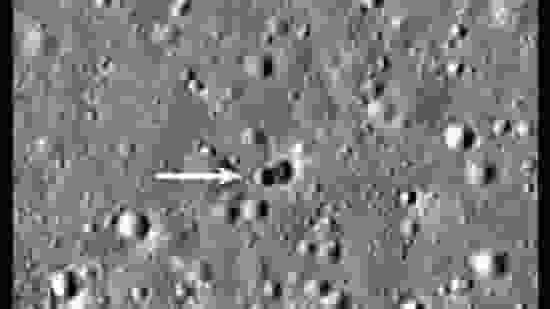According to a recent investigation, the case of the unexplained lunar crash is now firmly solved.
On March 4, 2022, a rocket body collided with the moon’s far side, creating a strange twin crater 95 feet (29 meters) wide. The collision was not unexpected; astronomers had been watching the renegade rocket for weeks and had predicted with remarkable precision where and when it would collide with the lunar surface.
The identification of the impactor, dubbed WE0913A by astronomers, was the source of the mystery.
The moon is no stranger to what one would term high-tech garbage—the ruins of spacecraft smashing onto the moon after their voyages through space have come to an end. Several Apollo rocket boosters are only a few instances of space technology that future astronauts may come across while exploring the chilly, silent, and airless lunar terrain.
Seven years ago, astronomers at the UArizona-led Catalina Sky Survey, one of the world’s premier programs tasked with identifying and researching asteroids that could pose a threat to Earth, found an object moving quickly between Earth and the moon. It was given the codename WE0913A, but its identity was unknown.
WE0913A was previously assumed to be an errant SpaceX Falcon 9 rocket booster from a 2015 launch, with a trajectory that put it on a course to strike the moon. Initial observations with the student-built Raptor Telescope and spectral analysis quickly identified the specific light signals bouncing off the object’s surface.
They found that WE0913A’s light reflection characteristic and trajectory through space suggested that it was a booster from a Chang’e 5-T1, a rocket launched in 2014 as part of China’s lunar exploration program. While the Chinese space agency reported that the rocket booster burned up in the Earth’s atmosphere upon re-entry, the United States asserted otherwise. The rocket’s third stage never re-entered the Earth’s atmosphere, according to Space Command.
Initial investigations revealed that it was the upper stage of the SpaceX Falcon 9 rocket that launched the Earth-observing DSCOVR satellite in February 2015. However, following more research, astronomers quickly landed on a different candidate: the third and topmost stage of China’s uncrewed Chang’e 5-T1 mission around the moon in October 2014.
One of the teams that reached that conclusion last year—a group located at the University of Arizona (UA)—has now confirmed it.
“In this paper, we present a trajectory and spectroscopic analysis using ground-based telescope observations to show conclusively that WE0913A is the Long March 3C rocket body (R/B) from the Chang’e 5-T1 mission,” the researchers wrote in a study published Thursday (Nov. 16) in the Planetary Science Journal, led by Tanner Campbell, a doctoral student in the UA’s Department of Aerospace and Mechanical Engineering.
According to Campbell and his colleagues, these two lines of evidence—how the object moved and what it was constructed of—leave little question regarding WE0913A’s provenance.
China, on the other hand, has worked to create mistrust. More than that, Chinese officials have stated that the upper stage of the Long March 3C burned up in the Earth’s atmosphere immediately after the launch of Chang’e 5-T1, which tested technologies in advance of the Chang’e 5 moon sample-return mission in 2020. However, the United States refuted this claim. Space Command stated last year that the item never reentered the atmosphere.
The new research also offers further information on the unusual crater left by the March 2022 moon crash.
The researchers compared WE0913A’s light curve—the variation in brightness over time—to that of thousands of computer-generated hypothetical space objects. And they discovered some fascinating discrepancies.
“Something that’s been in space as long as this is subjected to forces from the Earth’s and the moon’s gravity and the light from the sun,” Campbell said in a news release. “So you would expect it to wobble a little bit, particularly when you consider that the rocket body is a big empty shell with a heavy engine on one side. But this was just tumbling end-over-end, in a very stable way.”
According to team members, the most logical explanation for this behavior is a dumbbell-like item with significant mass at either end.
The upper stage’s two engines, for example, weighed a combined 2,400 pounds (1,090 kilograms) without fuel here on Earth. Given how stably WE0913A was tumbling and the form of the hole it gouged out of the lunar surface, Campbell believes the mass at the other end of the rocket stage was also in that ballpark.
“This is the first time we’ve seen a double crater” in a lunar impact, he explained. “We know that in the case of Chang’e 5 T1, its impact was almost straight down, and to get those two craters of about the same size, you need two roughly equal masses that are apart from each other.”
The unidentified bulk is too large to be the conventional instrument deck carried by the Long March 3C’s third stage, which Campbell estimated weighed around 60 pounds (27 kg). But that’s about the only conclusion we can draw.
“Obviously, we have no idea what it might have been—perhaps some extra support structure, additional instrumentation, or something else,” he added. “We probably won’t ever know.”




![Tyson Foods Plant [Photo: Food Manufacturing]](https://southarkansassun.com/wp-content/uploads/2023/08/iStock_1185520857__1_.5e441daa51cca-600x337.jpg)








![Silverado Senior Living Management Inc. [Photo: Los Angeles Times]](https://southarkansassun.com/wp-content/uploads/2023/10/download-6-4-600x337.jpg)

![China's Wuhan Institute of Virology [Photo: Nature]](https://southarkansassun.com/wp-content/uploads/2023/09/d41586-021-01529-3_19239608-600x337.jpg)















